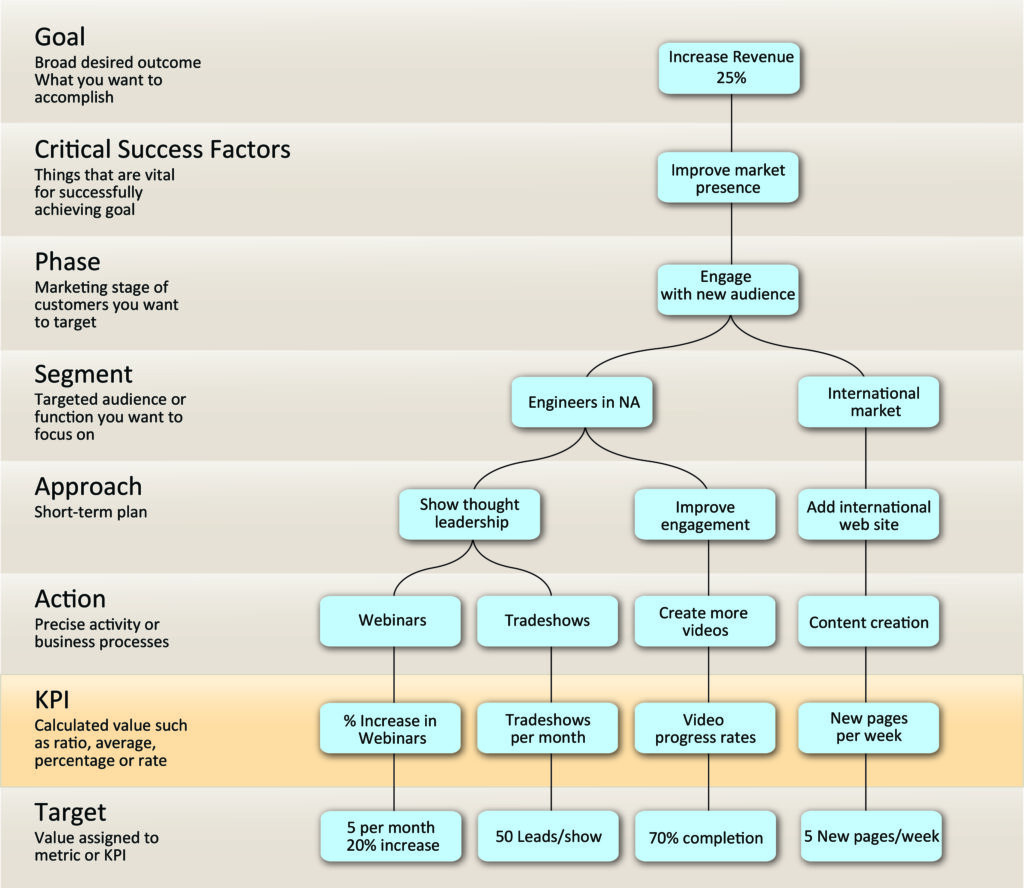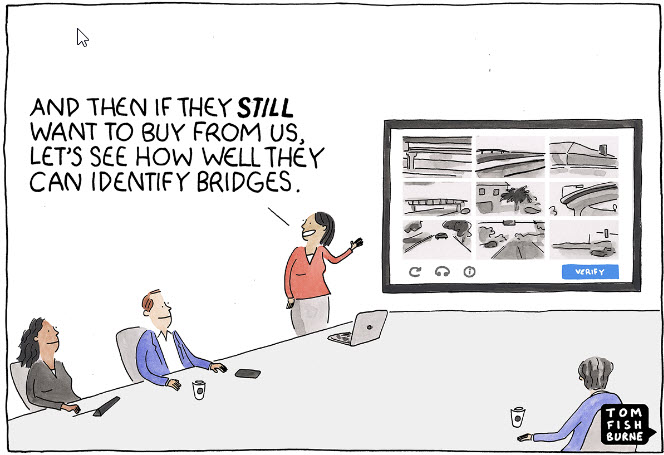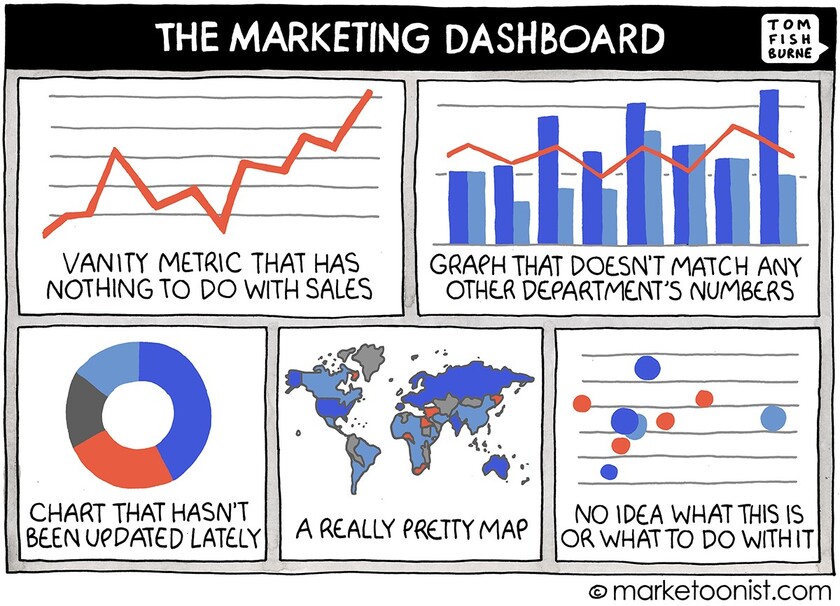A marketing strategy is simple. It’s knowing what your goal is and identifying activities that will get you there. That’s it.
However, the process of identifying specific tasks and effectively communicating this strategy can be challenging due to its complexity and abstract nature.
Marketing strategies encompass a myriad of components, ranging from defining target audiences and refining market positioning to crafting compelling messaging, selecting appropriate channels, and establishing metrics for measuring success. Navigating through these elements while ensuring clarity, depth, and relevance can indeed be a daunting task.
A significant hurdle in conveying a marketing strategy lies in the diverse perspectives and levels of familiarity among stakeholders. Team members or departments may possess varying degrees of knowledge regarding marketing concepts, tools, and tactics, leading to differing motivations and priorities. Harmonizing these perspectives and ensuring a shared understanding of strategic goals, audience insights, competitive analysis, and actionable plans becomes crucial yet intricate.
To overcome these challenges, it’s imperative to map out your strategy comprehensively. This involves delineating clear objectives, identifying key tasks and milestones, aligning resources effectively, and fostering open communication channels. By creating a structured roadmap that outlines the “why,” “what,” and “how” of your marketing strategy, you can streamline execution, promote collaboration, and drive meaningful results.
Moreover, adopting a collaborative approach that encourages input and feedback from diverse stakeholders can enhance buy-in, engagement, and ownership of the strategy. Clear, concise, and inclusive communication strategies play a pivotal role in ensuring that everyone is aligned with the overarching vision and strategic priorities.
A picture is worth a … (you know the saying)
A story should have a start and finish. So should your marketing strategy. There’s little point identifying all the things you want to accomplish if you don’t lay out a plan to achieve them. You need a way of determining what needs to be done and then a way of convincing others that your plan has merit.
Visual aids such as diagrams, Gantt charts, SWOT analyses, flowcharts, infographics, and storyboards can greatly enhance the clarity of your strategy. However, these tools sometimes fall short in illustrating the execution aspect of the strategy. While they highlight different areas needing attention, they may not clearly depict how these elements integrate or the specific actions required to achieve the goal.
A hierarchical approach can address this gap. In this structure, the primary goal sits at the top, with supporting blocks cascading downward. At the base of this pyramid are the actionable activities that need execution—the specific tasks and initiatives that must be completed. It’s crucial to involve all team members responsible for these activities in the strategy-building process. When team members have a hand in defining their targets and performance metrics, they become more engaged, motivated, and productive.
Additionally, when team members see how their individual targets and KPIs (Key Performance Metrics) fit into the organization’s broader objectives, they can appreciate the significance of their work and its impact on the whole team. This, in turn, can lead to greater self-management among staff and enable supervisors to focus on other tasks, secure in the knowledge that their team is performing effectively.
Strategy described in a hierarchy
Your strategy should always start by identifying your goal of what you are trying to accomplish. Let’s say we want to increase revenue by 25% year-over-year. Then you must determine what you need to do to reach that goal. But simply saying that hosting webinars will increase Revenue is a flawed approach and not well thought-out. That’s just guess work and people don’t buy into targets if they are not supported by logic. Follow the sequence listed below to identify WHY we have chosen to host webinars as part of our drive to increase Revenue.
| Step | Name in Hierarchy | Definition | Example |
|---|---|---|---|
| 1 | Goal | Broad desired outcome | Increase Revenue by 25% YOY |
| 2 | Critical Success Factor | This issomething that is vital to achieve the Goal | Improve market presence |
| 3 | Phase | State which marketing phase you are in (Acquire, Engage, Convert or Retain customers) | Engage with potential new customers |
| 4 | Segment | Target audience we want focus on | Engineers in North America |
| 5 | Approach | Short-term plan | Show thought leadership |
| 6 | Action | Activity or business process required | Host webinars |
| 7 | Key metrics or KPIs | Values to measure actions and activities | Track number of webinars and % increase in webinars month-over-month |
The hierarchical structure below shows this logic. The example is only one of the branches, but there can be many critical success factors or Segments and so on, creating a vivid map of what needs to get done. The example we gave follows the branch on the left in the diagram.

Conclusion
Mapping out your marketing strategy is not just about setting goals; it’s about creating a detailed plan of action and effectively communicating it to all stakeholders. The complexity and abstract nature of marketing strategies require a comprehensive approach that encompasses clear objectives, identification of key tasks, alignment of resources, and fostering open communication channels. Visual aids can enhance clarity, but a hierarchical structure ensures a cohesive roadmap for execution.
Moreover, involving all team members in the strategy-building process fosters engagement, ownership, and a deeper understanding of how individual contributions align with broader organizational objectives. This collaborative approach not only drives productivity and motivation but also enables supervisors to focus on strategic oversight with confidence in their team’s capabilities. Ultimately, a well-mapped marketing strategy sets the stage for streamlined execution, collaboration, and meaningful results in achieving your business objectives.






